View in other NatureServe Network Field Guides
NatureServe
Montana
Utah
Wyoming
Idaho
Wisconsin
British Columbia
South Carolina
Yukon
California
New York
Small Onion - Allium parvum
Other Names:
Dwarf Onion
State Rank Reason (see State Rank above)
Allium parvum extends into Montana on the periphery of its range in the western United States (USA). First documented in Montana in 1974, extensive survey efforts during the 1990s and early 2000s found numerous locations within Ravalli and Beaverhead Counties, and predominantly on the Bitterroot National Forest. Plants tend to occupy very small areas, yet populations can be quite large with some bearing several hundred plants. Plants grow in unique microsites where soils tend to be barren and/or disturbed, and competition from other plant species is less. Threats from non-native plants, particularly Bromus tectorum and Centaurea stoebe have been documented at more than one-third of Montana’s occurrences. Revisits to a small number of occurrences between 2002 and 2019 found larger populations of non-native plants and smaller population sizes of Allium parvum. At four occurrences, Allium parvum plants were not found (MTNHP 2023). Further, re-assessment of the 2009 SO-Ranks at five occurrences resulted in lower quality ratings (MTNHP 2023). Due to potentially declining population numbers the status of Allium parvum has changed from S3, ‘potentially at risk’ to S2S3, ‘potentially to or at risk’ of extirpation in Montana (MTNHP 2023). More revisits are needed to count and better map Allium parvum and non-native plant populations, assess habitat quality, and collect additional data to determine its state population trend and revise all 2009 SO-Ranks conducted by MTNHP. Further it may be necessary to conduct consecutive years of revisits or set up monitoring at specific occurrences to accurately detect the state’s population trend.
- Details on Status Ranking and Review
Range Extent
ScoreD - 1,000-5,000 sq km (~400-2,000 sq mi)
CommentThe 158 Allium parvum Species Occurrences cover an area of 1,441 square kilometers in Montana.
Area of Occupancy
ScoreE - 26-125 4-km2 grid cells
CommentOf the 30,590 4x4 square kilometer grid cells that cover Montana, 52 cells are occupied by Allium parvum SOs (all 158 SOs).
Number of Populations
ScoreD - 81 - 300
CommentThere are 158 Species Observations (SOs) for Allium parvum in Montana.
Environmental Specificity
ScoreB - Narrow. Specialist or community with key requirements common
CommentPlants grow in microsites of bare soil within grasslands.
Trends
ScoreFG - Decline of <30% to relatively stable
CommentRevisit data between 2002 and 2019 had 14 SOs with declining populations, 5 SOs with stable or increasing populations, and 5 SOs where population status could not be discerned. Of these plants could not be found at 4 SOs which had previous large populations. The 2009 SO Ranks that represent the occurrene's viability were re-evaluated for 5 occurrences in 2023 and dropped in quality by at least one category.
Threats
ScoreAB - Very High - High
CommentSee Threat Section in profile.
General Description
PLANTS: Herbaceous perennials that grow from bulbs and have a single relatively short, flattened scape, 3-6 cm tall. Scape is deciduous with leaves after seeds mature. Pressed specimens often have a broken scape. Sources: McNeal and Jacobsen in Flora of North America (FNA) 2002; Giblin et al. [eds.] 2018; Lesica et al. 2022
LEAVES: Two, 3-12 cm long, and curved to become sickle-shaped (more or less falcate), yet often are taller than the inflorescence. Alternately (whorled) arranged, and usually have an onion or garlic odor. Leaves are usually deciduous as the scape withers at anthesis. Blades are solid, flat, and (0.5) 1-2 (4) mm wide. Distal end (towards tip) may become winged or terete. Sources: McNeal and Jacobsen in FNA 2002; Giblin et al. [eds.] 2018; Lesica et al. 2022
INFLORESCENCE: Umbel; persistent and congested with 5 to 30 flowers. Pedicel, supporting the individual flower, is 5-10mm long. Umbel is subtended by 2 bracts (spathe bracts). Spathe bracts are persistent, 12-14 veined, mostly equal, ovate in shape, and acute to acuminate at the tips. Flowers have 6 white tepals (3 petals and 3 sepals), each with a purple mid-vein, 8-12 mm long; mid-vein is not prominently thickened. Tepal tips are acute or obtuse to rounded. Tepals are erect and more-or-less spread toward tips in flower; tepals more appressed in fruit. Sources: McNeal and Jacobsen in FNA 2002; Giblin et al. [eds.] 2018; Lesica et al. 2022
Allium is the Latin name for garlic (Giblin et al. [eds.] 2018).
Phenology
Plants flower in late May through June in Montana.
Diagnostic Characteristics
Bulbs are important for identifying species of
Allium, and should be collected if possible; the outer bulb coats should be left on or retained in collecting specimens. Montana is home to 10 documented native
Allium species of which half (5) are designated as Species of Concern (SOC) in the state. The following species are most similar to Small Onion.
Small Onion -
Allium parvum, SOC
*Leaves: 2, flat, curved to one side (falcate), 1-4 mm wide, often deciduous with scape.
*Scape: Short, 3-6 cm long, and usually shorter than leaves.
*Flowers: White tepals with purple midveins. Flower bracts, 2 ovate, acute to acuminate.
*Ovary: 3 crests adjacent to style; stamens included.
*Seed Surface: Smooth
*Bulb: Outer bulb coat membranous; adjacent bulbs not rhizomatous.
Dwarf Onion -
Allium simillimum, SOC
*Leaves: 2, channeled (u-shaped) flat, about 1 mm wide, persistent.
*Scape: Short, 2-6 cm long, slightly flattened, and partially growing in ground (subterranean).
*Flowers: White tepals with green to purple midveins. Flower bracts, 2 ovate, apiculate.
*Ovary: 3 crests adjacent to style; stamens included.
*Seed Surface: Smooth
*Bulb: Outer bulb coat membranous, forming a pattern of hexagonal reticulations. Bulbs usually solitary and not rhizomatous.
White Wild Onion -
Allium textile*Leaves: 2, channeled flat, 1-2 mm wide, barely persistent.
*Scape: Short to long, 5-25 cm long, and roundish (terete).
*Flowers: white tepals, sometimes pink tinged, with brown to pink midveins. Flower bracts 3, ovate, acuminate.
*Ovary: 6 crests adjacent to style; stamens included.
*Seed Surface: Smooth
*Bulb: Outer bulb coat fibrous, forming a net-like mesh pattern. Bulbs clustered and not rhizomatous.
Brandegee’s Onion -
Allium brandegeei, NOT DOCUMENTED
*Leaves: 2-5, flat or channeled, 2-6 mm wide, persistent, and sometimes falcate.
*Scape: Short, 3-10 cm long, and terete.
*Flowers: White to rose tepals with green midveins. Flower bracts are 2, ovate, and acuminate.
*Ovary: Nearly crestless; stamens included.
*Seed Surface: Smooth
*Bulb: Outer bulb coat membranous, forming a pattern of regular hexagonal reticulations. Bulbs solitary or if clustered then not rhizomatous.
TAXONOMYThe traditional Liliaceae or Lily Family has been split based on genetic research that shows that members are derived from more than one common ancestral group (polyphyletic); therefore, it is not suitable to place all members into the same Family (see Stevens 2001 for a summary).
Allium is often treated within the Amaryllidaceae or Amaryllis Family (Giblin et al. [eds.] 2018). However, there is still disagreement, and currently the Montana Natural Heritage Program and NatureServe follow the treatment by McNeal and Jacobsen in the Flora of North America (2002).
Species Range
Montana Range
Range Descriptions
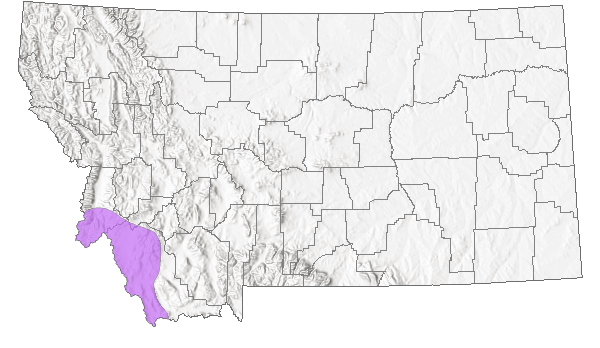
 Native
Native
Range Comments
Small Onion occurs in Montana on the edge of its range in the United States of America (USA). In the USA, plants occur from eastern Oregon to California, east to central Idaho and southwest Montana, and south into Nevada and Utah (Giblin et al. [eds.] 2018). In Montana, plants were first documented in 1974 (MTNHP 2023). Extensive surveys have documented occurrences in Beaverhead and Ravalli counties (Lesica et al. 2022).
Observations in Montana Natural Heritage Program Database
Number of Observations: 211
(Click on the following maps and charts to see full sized version)
Map Help and Descriptions
Relative Density
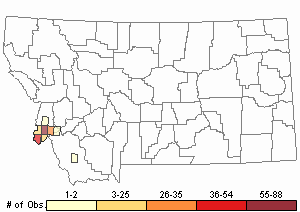
Recency
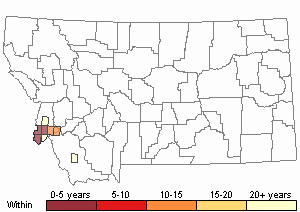

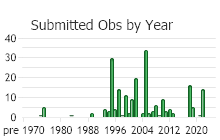
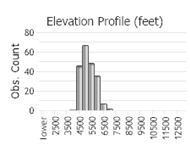 (Observations spanning multiple months or years are excluded from time charts)
(Observations spanning multiple months or years are excluded from time charts)
Habitat
Small Onion grows in open soil of the sagebrush steppe and open forest in the montane zone of Montana (Lesica et al. 2022). Plants grow in clay soil of slopes and talus from 1200 to 2800 meters (McNeal and Jacobsen in FNA 2002).
Within these habitat types, Small Onion colonizes areas of bare dirt or soil that is more barren with sparse vegetation (MTNHP 2023). Plants are often restricted to these patches of bare dirt where soil is often disturbed, such as by elk tracks and animal burrows (MTNHP 2023).
National Vegetation Classification System Groups Associated with this Species
Forest and Woodland
Low Elevation - Xeric Forest and Woodland
Shrubland
Sagebrush Shrubland
Grassland
Lowland - Prairie Grassland
Ecology
POLLINATORS The following animal species have been reported as pollinators of this plant species or its genus where their geographic ranges overlap:
Bombus bifarius,
Bombus centralis,
Bombus flavifrons,
Bombus huntii,
Bombus melanopygus,
Bombus sylvicola,
Bombus occidentalis, and
Bombus bohemicus (Macior 1974, Thorp et al. 1983, Colla and Dumesh 2010, Koch et al. 2012, Miller-Struttmann and Galen 2014, Williams et al. 2014).
PLANT DISPERSAL MECHANSIMSAfter seeds mature, the scape often forms an abcission layer causing it to break off (McNeal and Jacobsen
in FNA 2002). On the Bitterroot National Forest, field observations of the plant found that some scapes dry and snap-off. It was proposed that wind gusts or disturbance by animals acts as a seed dispersal mechanism that allows the dried scapes (with their umbel of seed capsules) to roll like small “tumbleweeds” across or down slopes (Odegard 1999).
Field observations on the Bitterroot National Forest also noticed that Small Onion plants are clustered on patches of bare dirt that often are raised several inches above the adjacent soil surface (Odegard and Goslin 1994). This could be caused by mole tunnels below the soil surface and it was proposed that moles might help to disperse bulbs (Odegard and Goslin 1994). Ground squirrel burrows have also been proposed as microhabitat for Small Onion plants to colonize (Odegard and Goslin 1994).
Reproductive Characteristics
Plants grow from bulbous roots. Rhizomes are absent between adjacent blubs (McNeal and Jacobsen in FNA 2002).
FLOWER
Flowers narrowly campanulate. Stigma is unlobed or obscurely 3-lobed. Ovary is single, crestless or with 3 low crests adjacent to the style; crests are broadly rounded processes. Stamens included (shorter than tepals). Sources: McNeal and Jacobsen in FNA 2002; Giblin et al. [eds.] 2018; Lesica et al. 2022
FRUIT
Fruit is an ovoid, 3-seeded capsule. Seed coat is smooth and dull. Sources: McNeal and Jacobsen in FNA 2002; Giblin et al. [eds.] 2018; Lesica et al. 2022
BULB
Ovoid to more or less globose, 1-2 cm by 0.7-2 cm. Symmetrical with roots coming from the base of the bulb. Outer coat encloses 1 or more bulbs, is gray to grayish brown, and membranous. Inner epidermis of the outer bulb coat is membranous and lacks cellular reticulations [without a net-like pattern of veins) or has indistinct reticulations of more or less quadrate cells found in the 2-3 rows distal to the roots, and without fibers. Inner coats are white or pinkish with obscure, quadrate-shaped cells. Sources: McNeal and Jacobsen in FNA 2002; Giblin et al. [eds.] 2018; Lesica et al. 2022
Stewardship Responsibility
Threats or Limiting Factors
STATE THREAT SCORE REASON
From 1995 to 2019, at least one type of threat has been reported at 76 of Montana’s 158 Species Occurrences (SOs; occurrences) of Small Onion. About a fifth of these 76 occurrences have 2 to 4 reported threats. Reported threats to Montana’s populations of Small Onion include trampling and ground disturbance caused by native ungulates, cattle, and horses; competition from non-native plant invasions; impacts from herbicide applications; and ground disturbance from logging operations (MTNHP Threat Assessment 2021; MTNHP 2023). Potential threats from all-terrain vehicle (ATV) use, wildfires, and mining operations have also been reported (MTNHP Threat Assessment 2021; MTNHP 2023). An overall State Threat Score of “high to very high” is assigned.
Native Ungulates
Ground disturbance and trampling by native ungulates have been reported at 16% [25 of 158 SOs] of Small Onion occurrences from 1989 to 2019 (MTNHP 2023). These surveys have observed direct trampling of plants, well used game trails through populations, and churned up soil. However, Small Onion colonizes soil that is more barren and animals that create ground disturbance may actually help to maintain necessary microhabitats. Therefore, it is unclear if ground disturbance by native ungulates is a direct threat that harms or could harm Small Onion plants or its habitat. Many exotic plants, including Cheatgrass and Spotted Knapweed, colonize disturbed soil and indirect impacts to Small Onion could occur when exotic plants are faster at establishing. Studies are needed to determine the relationship between habitat use by native ungulates and dispersal, colonization, and establishment by Small Onion, and that of exotic plants. See also sections on Ecology and Threats/Non-Native Plants.
Domestic Ungulates
Ground disturbance and trampling by domesticated cattle and horses have been reported at 6% [10 of 158 SOs] of Small Onion occurrences between 1993 and 2008 (MTNHP 2023). These surveys have observed ground disturbance and well used paths through populations. However, Small Onion colonizes soil that is more barren and animals that create ground disturbance may actually help to maintain necessary microhabitats. These surveys have not noted if soils have been compacted. Therefore, it is unclear if ground disturbance by domesticated animals is a direct threat that harms or could harm Small Onion plants or its habitat. Many exotic plants, including Cheatgrass and Spotted Knapweed, colonize disturbed soil and indirect impacts to Small Onion could occur when exotic plants are faster at establishing or if weed-free hay is not used. Studies are needed to determine the relationship between habitat use by domesticated animals and dispersal, colonization, and establishment by Small Onion, and that of exotic plants. See also sections on Ecology and Threats/Non-Native Plants.
Non-Native Plants
Non-native plants, namely Cheatgrass (Bromus tectorum) and Spotted Knapweed (Centaurea stoebe), have been documented as a threat at approximately 35% [55 of 158 SOs] of Small Onion occurrences between 1995 and 2019. Revisits to 24 of these occurrences took place between 2002 and 2019. The revisits found a population decline at 14 SOs, an increased or stable population at 5 SOs, and inconclusive trends at 5 SOs (MTNHP 2023). Further, revisits conducted in 2018 or 2019 at 4 of these SOs found no Small Onion plants, despite observation records that had shown abundant past populations (MTNHP 2023). The observation record provides evidence that Cheatgrass and Spotted Knapweed populations have increased with no clear evidence of management intervention; these are responsible for Small Onion’s apparent downward population trend (MTNHP 2023). Shifts in the distribution of plants also seem to be occurring at some of the occurrences revisited; however, differences in the resolution of older and newer population mapping need to be resolved (MTNHP 2023). Herbicide activities have been reported as a threat; however, potential effects have not been documented. More revisits are needed to count plants, better map Small Onion, Cheatgrass, Spotted Knapweed, and other non-native plant populations, assess habitat quality, and collect additional data in order to determine Small Onion’s state population trend and revise the 2009 SO-Ranks conducted by MTNHP. Further it may be necessary to conduct consecutive years of revisits or set up monitoring at particular SOs to accurately detect population trends.
Logging and Wood Harvesting
Timber harvesting and related actions were reported as a threat at 3% [4 of 158 SOs] of Small Onion occurrences in 1993, 2008, and 2009 (MTNHP 2023). A revisit to one of these occurrences found fewer Small Onion plants than past observations, but could not determine the cause as both Cheatgrass and Spotted Knapweed populations were present. Further, it was noted that the population might be shifting its distribution. Studies are needed to determine the effects of timber harvesting on Small Onion populations.
Fire and Related Activities
Wildfire and fire-related activities were reported as a threat at 4% [6 of 158 SOs] of Small Onion in 2001, 2002, and 2019 (MTNHP 2023). In 2000 wildfires burned large areas of the Bitterroot National Forest. The observation record for Small Onion listed 5 SOs where wildfire was light or patchy and potentially a threat to the plant. However, revisits to these occurrences have not been conducted, and it is unknown how Small Onion responded. A revisit to another occurrence found that the 2019 population was smaller in count than the previous 2008 report, and that a burn pile adjacent to the plants could be a contributing factor (MTNHP 2023). The effects of fire on Small Onion is unknown in Montana. Revisits to occurrences affected by the 2000 fire are needed to count plants, better map Small Onion, Cheatgrass, Spotted Knapweed, and other non-native plant populations, assess habitat quality, and collect additional data in order to determine population trends and revise the 2009 SO-Ranks conducted by MTNHP.
Mining Activities
The only Small Onion occurrence documented in 2002 in vicinity of Grasshopper Creek also occurred with a mining area. A revisit is needed to collect current data, more precisely map the population, and assess threats.
Recreational Activities
The use of ATVs has been reported at one Small Onion occurrence; however, the effects on the population remain unknown. A revisit is needed to more accurately assess this threat.
References
- Literature Cited AboveLegend:
 View Online Publication
View Online Publication Colla, S.R. and S. Dumesh. 2010. The bumble bees of southern Ontario: notes on natural history and distribution. Journal of the Entomological Society of Ontario 141:39-68.
Colla, S.R. and S. Dumesh. 2010. The bumble bees of southern Ontario: notes on natural history and distribution. Journal of the Entomological Society of Ontario 141:39-68. Flora of North America Editorial Committee. 2002. Flora of North America North of Mexico. Vol. 26. Magnoliophyta: Liliidae: Liliales and Orchidales. New York, NY: Oxford Univ. Press. xxvi + 723 pp.
Flora of North America Editorial Committee. 2002. Flora of North America North of Mexico. Vol. 26. Magnoliophyta: Liliidae: Liliales and Orchidales. New York, NY: Oxford Univ. Press. xxvi + 723 pp. Goslin, D. and C. Odegard. 1994. Plant Species of Special Concern Survey Form for Allium parvum. Montana Natural Heritage Program.
Goslin, D. and C. Odegard. 1994. Plant Species of Special Concern Survey Form for Allium parvum. Montana Natural Heritage Program. Hitchcock, C.L. and A. Cronquist. 2018. Flora of the Pacific Northwest: An Illustrated Manual. Second Edition. Giblin, D.E., B.S. Legler, P.F. Zika, and R.G. Olmstead (eds). Seattle, WA: University of Washington Press in Association with Burke Museum of Natural History and Culture. 882 p.
Hitchcock, C.L. and A. Cronquist. 2018. Flora of the Pacific Northwest: An Illustrated Manual. Second Edition. Giblin, D.E., B.S. Legler, P.F. Zika, and R.G. Olmstead (eds). Seattle, WA: University of Washington Press in Association with Burke Museum of Natural History and Culture. 882 p. Koch, J., J. Strange, and P. Williams. 2012. Bumble bees of the western United States. Washington, DC: USDA Forest Service, Pollinator Partnership. 143 p.
Koch, J., J. Strange, and P. Williams. 2012. Bumble bees of the western United States. Washington, DC: USDA Forest Service, Pollinator Partnership. 143 p. Lesica, P., M.T. Lavin, and P.F. Stickney. 2022. Manual of Montana Vascular Plants, Second Edition. Fort Worth, TX: BRIT Press. viii + 779 p.
Lesica, P., M.T. Lavin, and P.F. Stickney. 2022. Manual of Montana Vascular Plants, Second Edition. Fort Worth, TX: BRIT Press. viii + 779 p. Macior, L.M. 1974. Pollination ecology of the Front Range of the Colorado Rocky Mountains. Melanderia 15: 1-59.
Macior, L.M. 1974. Pollination ecology of the Front Range of the Colorado Rocky Mountains. Melanderia 15: 1-59. Miller-Struttmann, N.E. and C. Galen. 2014. High-altitude multi-taskers: bumble bee food plant use broadens along an altitudinal productivity gradient. Oecologia 176:1033-1045.
Miller-Struttmann, N.E. and C. Galen. 2014. High-altitude multi-taskers: bumble bee food plant use broadens along an altitudinal productivity gradient. Oecologia 176:1033-1045. Montana Natural Heritage Program (MTNHP). 2023. Revising the S-Rank of Allium parvum using observation, species occurrence, and threat data from the MTNHP botany database. Excel spreadsheet. Compiled and analyzed by Andrea Pipp, Botanist, Montana Natural Heritage Program, Helena, Montana.
Montana Natural Heritage Program (MTNHP). 2023. Revising the S-Rank of Allium parvum using observation, species occurrence, and threat data from the MTNHP botany database. Excel spreadsheet. Compiled and analyzed by Andrea Pipp, Botanist, Montana Natural Heritage Program, Helena, Montana. MTNHP Threat Assessment. 2021. State Threat Score Assignment and Assessment of Reported Threats from 2006 to 2021 for State-listed Vascular Plants. Botany Program, Montana Natural Heritage Program, Helena, Montana.
MTNHP Threat Assessment. 2021. State Threat Score Assignment and Assessment of Reported Threats from 2006 to 2021 for State-listed Vascular Plants. Botany Program, Montana Natural Heritage Program, Helena, Montana. Odegard, C. 1999. Rare plant element occurrence form(s). Bitterroot National Forest for the Montana Natural Heritage Program.
Odegard, C. 1999. Rare plant element occurrence form(s). Bitterroot National Forest for the Montana Natural Heritage Program. Stevens, P.F. 2001 onward. Angiosperm Phylogeny Website. Version 13. Available at www..mobot.org/MOBOT/research/APweb
Stevens, P.F. 2001 onward. Angiosperm Phylogeny Website. Version 13. Available at www..mobot.org/MOBOT/research/APweb Thorp, R.W., D.S. Horning, and L.L. Dunning. 1983. Bumble bees and cuckoo bumble bees of California (Hymenoptera: Apidae). Bulletin of the California Insect Survey 23:1-79.
Thorp, R.W., D.S. Horning, and L.L. Dunning. 1983. Bumble bees and cuckoo bumble bees of California (Hymenoptera: Apidae). Bulletin of the California Insect Survey 23:1-79. Williams, P., R. Thorp, L. Richardson, and S. Colla. 2014. Bumble Bees of North America. Princeton, NJ: Princeton University Press. 208 p.
Williams, P., R. Thorp, L. Richardson, and S. Colla. 2014. Bumble Bees of North America. Princeton, NJ: Princeton University Press. 208 p.
- Additional ReferencesLegend:
 View Online Publication
View Online Publication
Do you know of a citation we're missing? Lesica, P., M.T. Lavin, and P.F. Stickney. 2012. Manual of Montana Vascular Plants. Fort Worth, TX: BRIT Press. viii + 771 p.
Lesica, P., M.T. Lavin, and P.F. Stickney. 2012. Manual of Montana Vascular Plants. Fort Worth, TX: BRIT Press. viii + 771 p.
- Web Search Engines for Articles on "Small Onion"





